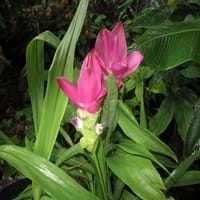Life Span
Perennial
Perennial
Type
Bulb or Corm or Tuber
Tender Perennial
Origin
South America
Southeastern Asia
Types
Pamianthe cardenasii , Pamianthe parviflora , Pamianthe peruviana
Not Available
Number of Varieties
Not Available
Habitat
All sorts of environments
Open grasslands, Wild
USDA Hardiness Zone
8-10
8-11
Sunset Zone
21,22
H1, H2, 14, 15, 16, 17, 18, 19, 20, 21, 22, 23, 24
Habit
Clump-Forming
Clump-Forming
Flower Color
White
White, Yellow, Pink, Light Pink, Rose
Flower Color Modifier
Bicolor
Bicolor
Fruit Color
Green
Not Available
Leaf Color in Spring
Dark Green
Green, Light Green, Blue Green
Leaf Color in Summer
Light Green
Green, Blue Green
Leaf Color in Fall
Several shades of Green
Green, Blue Green, Yellow green
Leaf Color in Winter
Light Green
Light Green
Leaf Shape
Strap shaped
Lance shaped
Plant Season
Spring, Summer, Fall
Summer, Fall
Sunlight
Partial Sun, Partial shade
Partial Sun, Partial shade
Type of Soil
Loam, Sand
Loam
The pH of Soil
Acidic, Neutral, Alkaline
Neutral
Soil Drainage
Average
Average
Bloom Time
Spring, Late Spring, Early Summer, Summer, Late Summer
Summer, Late Summer, Early Fall, Fall
Tolerances
Drought
Drought
Where to Plant?
Ground, Pot
Container, Ground, Pot
How to Plant?
Offsets
Rhizome division, Seedlings
Plant Maintenance
Medium
Medium
Watering Requirements
Keep the ground moist but not water-logged
Do not let dry out between waterings, Requires a lot of watering
In Summer
Lots of watering
Lots of watering
In Spring
Moderate
Moderate
In Winter
Average Water
Average Water
Soil pH
Acidic, Neutral, Alkaline
Neutral
Soil Type
Loam, Sand
Loam
Soil Drainage Capacity
Average
Average
Sun Exposure
Partial Sun, Partial shade
Partial Sun, Partial shade
Pruning
Pinch or prune as they grow to promote branching and bushiness, Remove damaged leaves, Remove dead branches, Remove dead leaves, Requires little pruning
Remove damaged leaves, Remove dead branches, Remove dead leaves
Fertilizers
All-Purpose Liquid Fertilizer, High phosphorus
Complete balanced fertilizer
Pests and Diseases
Leaf spot, Mosaic viruses
Fungal Diseases, Red blotch
Plant Tolerance
Drought
Drought
Flower Petal Number
Single
Single
Fragrant Bark/Stem
No
Yes
Foliage Texture
Coarse
Coarse
Foliage Sheen
Glossy
Matte
Attracts
Bees, Birds, Bumblebees, Butterflies, Hummingbirds, pollinators
Snails
Allergy
Unknown
poisonous if ingested, Skin irritation
Aesthetic Uses
Beautification, Bouquets, Ornamental use, Showy Purposes
Cut Flowers, Showy Purposes
Beauty Benefits
No Beauty Benefits
Not Available
Environmental Uses
Air purification
Air purification
Medicinal Uses
No Medicinal Use
Antidiarrhoeal, Anti-oxidant
Part of Plant Used
Not Available
Flowers
Other Uses
Beneficial species for attracting pollinators, Decoration Purposes
Used as a vegetable, Used as Ornamental plant
Used As Indoor Plant
No
Yes
Used As Outdoor Plant
Yes
Yes
Garden Design
Bog Garden, Container, Feature Plant, Foundation, Mixed Border, Water Gardens
Bedding Plant, Container, Feature Plant, Mixed Border, Tropical
Botanical Name
HYMENOCALLIS longipetala
CURCUMA alismatifolia
Common Name
Peruvian Daffodil, Spiderlily
Hidden Ginger, Siam Tulip
In Hindi
peruvian daffodil
Siam Tulip
In German
peruvian daffodil
Siam Tulip
In French
peruvian daffodil
Siam Tulip
In Spanish
Pamianthe
Tulipán de Tailandia
In Greek
peruvian daffodil
Siam Tulip
In Portuguese
peruvian daffodil
Siam Tulip
In Polish
peruvian daffodil
Siam Tulip
In Latin
peruvian daffodil
Tulip Siam
Phylum
Magnoliophyta
Tracheophyta
Class
Liliopsida
Liliopsida
Order
Asparagales
Zingiberales
Family
Amaryllidaceae
Zingiberaceae
Clade
Angiosperms, Monocots
Angiosperms, Commelinids, Monocots
Tribe
Clinantheae
Zingibereae
Subfamily
Amaryllidoideae
Zingiberoideae
Number of Species
Not Available
Not Available
Season and Care of Peruvian Daffodil and Siam Tulip
Season and care of Peruvian Daffodil and Siam Tulip is important to know. While considering everything about Peruvian Daffodil and Siam Tulip Care, growing season is an essential factor. Peruvian Daffodil season is Spring, Summer and Fall and Siam Tulip season is Spring, Summer and Fall. The type of soil for Peruvian Daffodil is Loam, Sand and for Siam Tulip is Loam while the PH of soil for Peruvian Daffodil is Acidic, Neutral, Alkaline and for Siam Tulip is Neutral.
Peruvian Daffodil and Siam Tulip Physical Information
Peruvian Daffodil and Siam Tulip physical information is very important for comparison. Peruvian Daffodil height is 61.00 cm and width 61.00 cm whereas Siam Tulip height is 60.00 cm and width 60.00 cm. The color specification of Peruvian Daffodil and Siam Tulip are as follows:
Peruvian Daffodil flower color: White
Peruvian Daffodil leaf color: Dark Green
Siam Tulip flower color: White, Yellow, Pink, Light Pink and Rose
- Siam Tulip leaf color: Green, Light Green and Blue Green
Care of Peruvian Daffodil and Siam Tulip
Care of Peruvian Daffodil and Siam Tulip include pruning, fertilizers, watering etc. Peruvian Daffodil pruning is done Pinch or prune as they grow to promote branching and bushiness, Remove damaged leaves, Remove dead branches, Remove dead leaves and Requires little pruning and Siam Tulip pruning is done Remove damaged leaves, Remove dead branches and Remove dead leaves. In summer Peruvian Daffodil needs Lots of watering and in winter, it needs Average Water. Whereas, in summer Siam Tulip needs Lots of watering and in winter, it needs Average Water.





